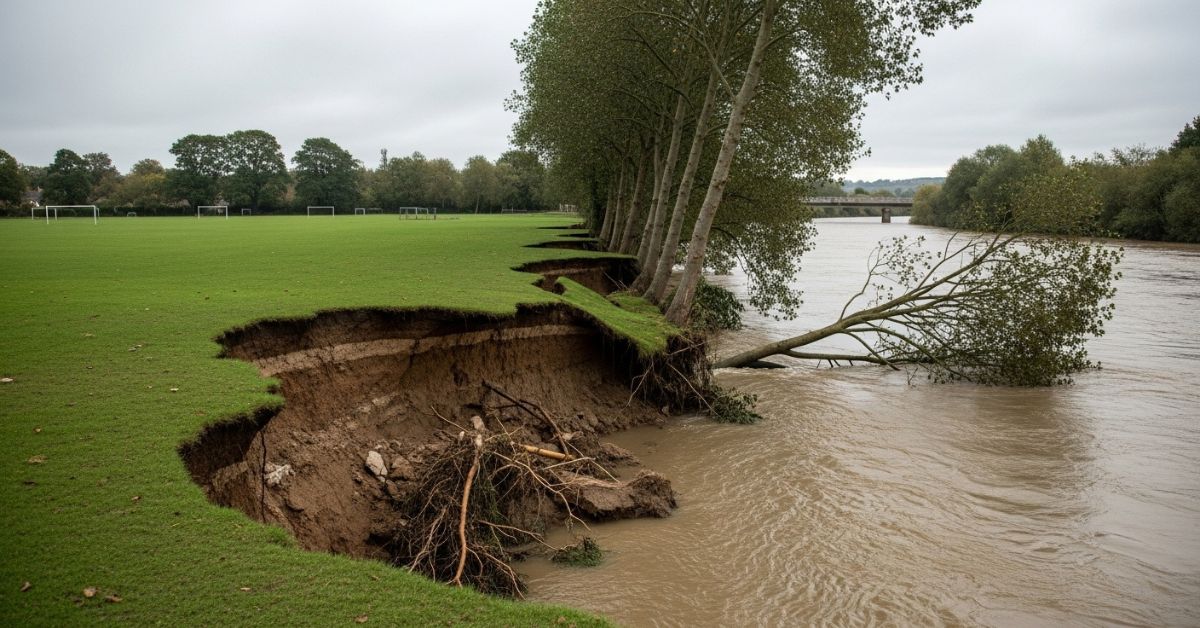The quiet community around Iford Playing Fields has been rocked by an unexpected and alarming event — a sudden riverbank collapse that has raised urgent questions about safety, environmental management, and the future of one of the area’s most beloved green spaces.
Once a peaceful riverside haven for walkers, joggers, and families, Iford has now become the focal point of growing concern. Locals are wondering: What caused the collapse? Could it happen again? And what steps are being taken to prevent future disasters?
This in-depth report unpacks everything — from the science behind the erosion to the human stories affected by it, and most importantly, what comes next for the community and local environment.
The Day It Happened: A Riverbank Gives Way
On a grey, rain-soaked morning, residents noticed something unsettling. A large section of the riverbank at Iford Playing Fields had given way overnight, collapsing into the River Stour. The once-sturdy edge of the path now looked jagged and unstable, with several metres of soil missing.
Witnesses described hearing a low rumble in the early hours, followed by the sight of trees and fencing sliding into the water. For locals who walk the trail daily, the shock was immediate. Within hours, council officials arrived to cordon off the area, fearing further collapse.
Experts quickly linked the incident to ongoing erosion and recent heavy rainfall. But many residents believe this disaster was years in the making, a combination of natural forces and neglect. The collapse not only disrupted a key public space — it also exposed the fragile relationship between development, climate, and nature.
Understanding What Caused the Collapse
While heavy rainfall may have been the final trigger, the underlying causes go much deeper. Erosion, a slow but relentless natural process, has been gnawing at the Iford riverbank for years.
1. The Role of Soil Saturation
Weeks of rain had left the soil saturated, weakening the compact layers that held the riverbank together. When the water level rose, the pressure against the bank intensified, eventually causing it to give way. This type of failure is common in soft, silty riverbanks — especially those without adequate vegetation or retaining structures.
2. Human Activity and Land Use
Over time, increased foot traffic, mowing, and nearby construction have subtly altered the soil structure. Natural vegetation, which once anchored the bank, has been replaced by grass and compacted soil. Without deep-rooted plants to stabilize the ground, erosion accelerated.
3. Rising River Levels and Climate Change
Local hydrologists point out that the River Stour’s water levels have become more unpredictable due to changing rainfall patterns. Climate change is amplifying seasonal floods, making banks more prone to collapse. What was once a 50-year flood event is now occurring every decade.
In short, the collapse was no random event — it was the result of long-term environmental stress meeting short-term weather extremes.
Who’s at Risk After the Collapse?
The danger isn’t over. Following the initial collapse, experts have warned that other sections of the riverbank could also be at risk. The implications stretch beyond environmental damage — they touch local safety, property, and community wellbeing.
1. Residents and Walkers
The most immediate risk is to walkers and cyclists who use the riverside path daily. The council has fenced off affected areas, but erosion can be unpredictable. Even stable-looking ground may conceal soft soil underneath, ready to give way without warning.
2. Local Wildlife and Habitats
Iford Playing Fields is home to a variety of bird species, insects, and aquatic life. The sudden collapse disturbed nests, uprooted trees, and sent sediment into the river, potentially harming fish and water plants. Conservationists fear the loss of vegetation could have long-term ecological consequences.
3. Infrastructure and Nearby Properties
Although no homes were directly damaged, nearby areas could face secondary risks. If erosion continues unchecked, paths, playgrounds, and even underground utilities might be compromised. Preventative engineering works are now a top priority.
Community Reaction: Shock, Worry, and Determination
In the days following the collapse, local residents gathered near the site, expressing shock and concern. Many recalled previous warnings about erosion, suggesting the signs had been visible for years.
Social media filled with photos and videos showing the extent of the damage. Some posts accused the local council of ignoring earlier complaints about crumbling riverbanks. Others shared memories of picnics, football matches, and walks now overshadowed by safety fears.
However, the mood isn’t entirely grim. Community groups have already begun organizing clean-up efforts and calling for long-term restoration projects. For many, this incident has reinforced the importance of protecting natural spaces before they reach breaking point.
Council and Expert Response
The local council moved quickly to assess the situation. Engineers and environmental officers were dispatched to measure the extent of the damage and determine whether other sections of the riverbank were unstable.
Officials confirmed that the collapse posed no immediate threat to nearby housing, but acknowledged the need for urgent repairs and better long-term planning. Temporary barriers have been set up, and the public is being asked to avoid restricted zones until further notice.
Environmental Impact Studies Underway
Specialists have begun studying soil samples and water quality to understand how the collapse affected the local ecosystem. Early reports suggest increased sedimentation in the river, which can suffocate aquatic life if left untreated.
The council also stated that replanting vegetation will be a key part of recovery efforts — using native plants with deep root systems to help stabilize the soil naturally.
The Environmental Toll: Beyond What Meets the Eye
While the visible damage is dramatic, the unseen consequences may be even greater. When a riverbank collapses, tons of sediment rush into the water, disrupting the delicate balance of oxygen and light that aquatic ecosystems rely on.
Erosion and Water Quality
Excess soil in the river makes the water cloudy, blocking sunlight and choking plants. It also clogs fish gills and smothers insect larvae — small but vital parts of the food chain. Over time, this can lead to a decline in biodiversity, altering the river’s natural rhythm.
Loss of Trees and Vegetation
Trees and shrubs not only stabilize soil but also provide shelter for wildlife. Their sudden loss means more exposure to sun and wind, which accelerates further erosion. Replanting efforts will need to consider both ecological balance and long-term soil retention.
The incident has served as a stark reminder that environmental neglect has real-world consequences, often unfolding slowly until disaster strikes.
Preventing Future Collapses — Lessons from Iford
The tragedy at Iford Playing Fields offers valuable lessons for other riverfront communities. It underscores the importance of proactive maintenance, smart engineering, and public awareness.
1. Regular Monitoring
Erosion rarely happens overnight. Early warning systems — such as soil moisture sensors and visual inspections — can detect subtle changes before they become dangerous. Councils need structured monitoring schedules to stay ahead of nature’s slow but steady work.
2. Eco-Friendly Engineering
Rather than relying solely on concrete walls or metal reinforcements, experts recommend “soft engineering” techniques like planting willows, installing coir rolls, and using natural barriers. These methods absorb water flow while supporting biodiversity.
3. Climate-Resilient Planning
Future flood defenses must account for climate change impacts. Infrastructure and parks should be designed with flexible drainage, elevated walkways, and adaptive green zones that can handle excess water safely.
The Human Element — Memories and Meaning Lost
Beyond the environmental damage, the collapse has emotional weight. Iford Playing Fields isn’t just a stretch of grass and river — it’s part of local identity. Generations have played sports there, walked their dogs, and enjoyed the peace of open space.
Residents describe feeling “heartbroken” at seeing a familiar path vanish. For many older locals, it brought back memories of previous floods, sparking worries about how fragile their landscape has become.
This shared sense of loss could, however, become a turning point — a chance for the community to unite around a shared mission: restore, rebuild, and protect.
What Comes Next for Iford Playing Fields
Restoration plans are already being drafted. The council, alongside environmental agencies and local volunteers, aims to rebuild the damaged sections while improving the site’s resilience.
1. Short-Term Recovery
The first step will be stabilizing the remaining bank. Engineers will likely install temporary supports, remove debris from the river, and reinforce weakened edges. Public access will remain limited until these works are complete.
2. Long-Term Regeneration
Once the site is safe, replanting will begin — focusing on native species like willow and alder, known for their strong root systems. Community-led initiatives, including tree-planting events and river cleanups, are being planned to involve local residents in the recovery.
3. A New Approach to Maintenance
Officials have promised more frequent inspections, better drainage management, and ongoing collaboration with environmental groups. The goal isn’t just to repair, but to future-proof Iford Playing Fields for generations to come.
Actionable FAQs — What People Are Asking
What caused the riverbank collapse at Iford Playing Fields?
The collapse was caused by a combination of factors: saturated soil from weeks of rainfall, ongoing erosion, and a lack of deep-rooted vegetation to hold the bank together. Rising river levels from recent storms acted as the final trigger.
Is Iford Playing Fields safe to visit now?
Most of the site remains open, but areas near the riverbank are fenced off for safety. Visitors should stay behind barriers and follow posted warnings while restoration work continues.
Can this kind of collapse happen again?
Yes, if underlying erosion and drainage issues aren’t addressed. However, planned restoration and replanting will greatly reduce the risk by strengthening the soil and improving water flow management.
What is being done to restore the damaged area?
The council is working with environmental engineers to rebuild the riverbank using eco-friendly methods — including natural reinforcements, replanting native trees, and installing erosion-resistant materials.
How can the community help?
Locals can participate in volunteer planting days, report signs of erosion, and support conservation groups. Staying informed and involved ensures long-term protection for the playing fields and surrounding wildlife.
Conclusion — A Wake-Up Call for Every Community
The Iford Playing Fields riverbank collapse isn’t just a local incident — it’s a warning about the growing vulnerability of natural landscapes in a changing climate. It highlights the need for foresight, investment, and community involvement in protecting shared spaces.
Nature always gives signs before disaster strikes — cracks in the soil, shifting ground, rising water. Ignoring those signs can turn slow erosion into sudden catastrophe. But with awareness and action, communities like Iford can turn tragedy into transformation.
The hope now is that Iford’s story becomes not one of loss, but of resilience — a reminder that even when the ground gives way, determination and care can rebuild it stronger than before.


